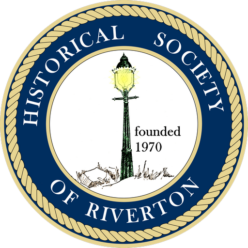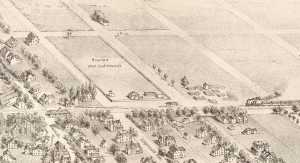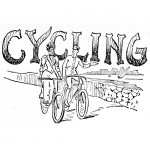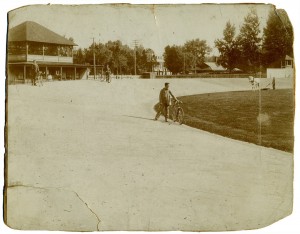 History may indeed have been made on June 12, 2011, if the recently held Historic Riverton Criterium turns out to become another borough tradition as many hope.
History may indeed have been made on June 12, 2011, if the recently held Historic Riverton Criterium turns out to become another borough tradition as many hope.
HSR member Mrs. Pat Solin had a ringside seat for the main event from her front door at Fourth and Main .
She writes:

“…all cars had to be off the streets. Police set up barriers and town maintenance folk cleaned the street of debris to ensure a safe ride for the participants. The weather was beautiful for the race… We could hear a live band, and folks lined the street along the route to cheer for their favorite riders. Our neighbors had company over and made it an ‘event.’ We watched the riders from time to time either from the curb or from within the house because, as you noted, they sped by directly in front of the house.”
I knew that the race was coming because HSR President Gerald Weaber had copied me on an email that he had received. Someone helping with organizing the Historic Riverton Criterium had a question about the age of a house.

First off, I had to look up “criterium.” in the dictionary.
Then I anticipated that the organizers might want to know that Riverton once held bicycle races and even had a bicycle track, now long gone. I didn’t hear anything further after I sent along a link to Mrs. Pat Solin’s September 2009 Gaslight News article, “The Fine Grounds of the Riverton Athletic Association,” and another link from the New York Times archives showing a map of the old bicycle track near Thomas Avenue and Broad Street.
In her September GN piece, Pat traces the development of the Riverton Athletic Association from its beginning in July 1865, just after the Civil War, as simply some amateurs playing baseball in Biddle’s apple orchard to its involvement in an array of other popular sports, including bicycling. A highlight of the story is the account of a contest that will probably never again be duplicated, a 150-mile race from the steps of the New York Times building in New York City and culminating at Riverton’s packed to capacity bicycle stadium. Click here to read the whole incredible story.

In any case, I imagine that the information eventually made its way to Jeannie O’Sullivan, staff writer for the Burlington County Times, who wrote a delightful story cleverly contrasting the old and new races. You can find the complete article, photos, and a YouTube video by clicking on this link.
You can read the chatter between the members of the Historic Riverton Criterium Facebook group as the event progressed from planning and development, to race day, and posting of the results. In addition, there are dozens of photographs of the day’s activities, posted by several different photographers. The students of Mr. Christian Hochenberger’s Shawnee High School Photography Club posted over 300 photos here. Do not miss viewing the set taken by Lee Rogers, owner of Bicycle Therapy, a race sponsor who posted on Flickr, the photo-sharing site.
If you’d like to see more New York Times articles of yesteryear, use the advanced search option of the New York Times archive to search issues from 1851-1980 for Riverton-related articles. Browse at your own risk, however, as it can not only become addictive, but hours can fly by reading about those times past.

Another place to look for sports news of all sorts related to Riverton is in the pages of The Sporting Life, a weekly sports news publication printed in Philadelphia from 1885-1917, and now found online at the sports research library of the LA84 Foundation. There you can read about the famous Riverton Gun Club, the legendary “Riverton Nines” baseball team, yacht races, football, bicycle races, swimming–even cricket. Here is the link for the LA84 search page.
In addition to enlarging my vocabulary, further investigation into this cycling phenomenon has resulted in finding yet another “Yesterday” column written by Mrs. Betty B. Hahle over thirty years ago for the May 1981 issue of Gaslight News which sheds more light on those bicycle races of the late 19th century. Following is an account of the opening of the Riverton Athletic Association’s new quarter-mile track in 1894. As Betty wished, the re-publication of her work which follows is printed exactly as it originally appeared:
“As bicycling grew in popularity, Wheelmen’s Clubs were formed and meets became a part of the growing interest in athletic events.

Riverton’s team used a track on Fulton street, below the railroad, and then a larger one above the railroad, where Lippincott, Thomas, and 7th streets are today. June of 1894 saw the new track completed there, in time for the riders to begin training for the big meet on July 4th. It was the widest 1/4 mile track in the world, designed by O.S. Bunnell of Philadelphia, a much-respected cycler who would also be the referee on the big day.

And what a day it must have been! Riverton, with a population numbering only a few hundred, had an attendance of nearly 4000, according to the papers. There were 8 class-A events, trick riders, an exhibition ½-mile ride by Harrison Barcus, a 5-year-old, on a 10 lb. wheel, and a 5-mile event that ‘kept spectators at fever heat from start to finish’. Julius Blauberg, a prominent caterer from Philadelphia, had charge of refreshment stands, and prizes–oh, the prizes…5 diamonds, gold and silver medals, jewelry, and many other valuable articles. A.J. Briggs, Riverton’s Athletic Association manager, kept things moving and was careful that all activities and decisions were fair. Soon color was introduced into the meets by having riders wear brightly colored shirts instead of numbers to identify them–and shortly there followed items of vandals breaking into the athletic building on the grounds and making off with ‘articles of clothing’. Fireworks were held at the bicycle grounds after the races.
In 1894 W.F. Sims was out to break his record of a mile in 2.11. He aimed to do it in 2 minutes–and made it. (Speed on the track was one thing; it was something else along the streets and paths of town, and increasingly there were reports of children being knocked down, teeth being lost in the process, and broken bones of older victims. Tempers grew short with this behavior–even on Sunday–and there were calls for dealing more severely with the culprets.”
Saying, “It makes obvious sense to tie in the racing history and the Historic Riverton Criterium,” Carlos Rogers, a 20-year veteran competitive cyclist whose vision it was to bring the amateur cycling meet to his newly adopted hometown (by marriage to the former Adrienne Gaughn), started planning for the race late last year. Mr. and Mrs. Rogers are owners and operators of the highly regarded Hush Salon in Philadelphia’s Old City District.
The novice promoter acknowledged the first-time challenges of navigating those uncertain waters of borough government and tradition and was, in the end, elated at the result. Taking stock of the event and the public’s reception to it, Carlos remarked, “By all accounts, from borough officials, riders, residents, and spectators, it was a resounding success.”
Let’s hope that history repeats itself in this case and that the Historic Riverton Criterium returns again next year. In the process we shall add another chapter to the history of cycling in Riverton, NJ. – John McCormick, Gaslight News editor

![Fred_Moore_Center_1872 [787x1200]](https://rivertonhistory.com/wp-content/uploads/2011/03/Fred_Moore_Center_1872-787x1200-671x1024.jpg)


